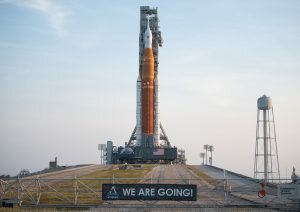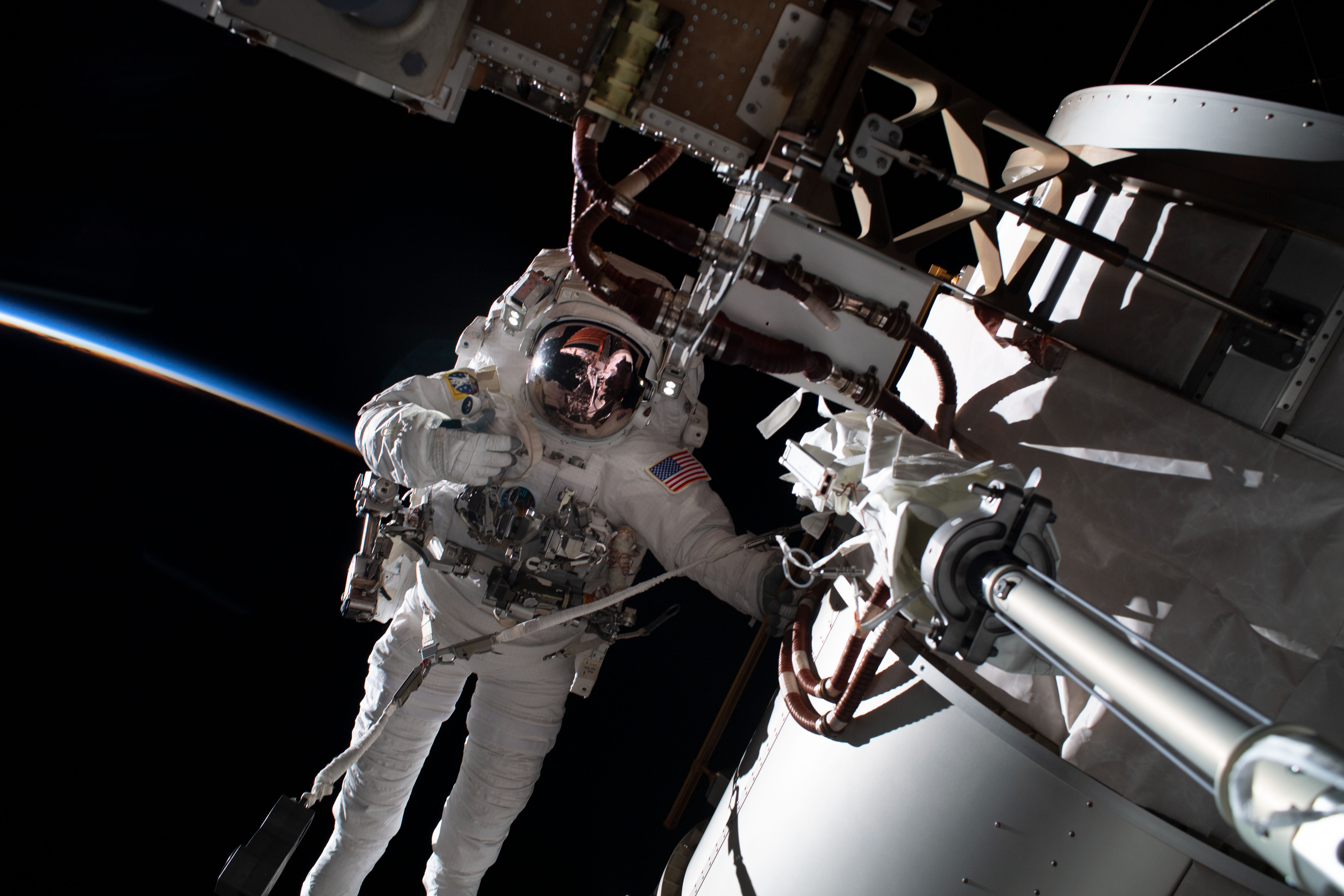August 19, 2022
MEDIA ADVISORY M22-116
NASA Sets Launch Coverage for Artemis Mega Moon Rocket, Spacecraft
NASA will provide coverage of prelaunch, launch, and postlaunch activities for Artemis I, the first integrated test of NASA’s Orion spacecraft, Space Launch System (SLS) rocket, and the ground systems at the agency’s Kennedy Space Center in Florida. This uncrewed flight test around the Moon will pave the way for a crewed flight test and future human lunar exploration as part of Artemis.
The SLS rocket is targeted to launch during a two-hour window that opens at 8:33 a.m. EDT Monday, Aug. 29, from Launch Pad 39B at Kennedy.
The rocket and spacecraft arrived at its launch pad Wednesday after the nearly 10-hour, four-mile trek from the Vehicle Assembly Building. A livestream of the rocket and spacecraft at the launch pad currently is available on the NASA Kennedy YouTube channel.
Live coverage of events will air on NASA Television, the NASA app, and the agency’s website, with prelaunch events starting Monday, Aug. 22. The launch countdown will begin Saturday, Aug. 27, at 10:23 a.m.
A live broadcast of the launch also will include celebrity appearances by Jack Black, Chris Evans, and Keke Palmer, as well as a special performance of “The Star-Spangled Banner” by Josh Grobin and Herbie Hancock. It also will feature a performance of “America the Beautiful” by The Philadelphia Orchestra and cellist Yo-Yo Ma, conducted by Yannick Nézet-Séguin.
The first in a series of increasingly complex missions, Artemis I will be an uncrewed flight test that will provide a foundation to extend human presence to the Moon and beyond. The mission will demonstrate the performance of the SLS rocket and test Orion’s capabilities over the course of about six weeks as it travels about 40,000 miles beyond the Moon and back to Earth.
A limited number of seats inside the auditorium at Kennedy will be available to on-site journalists on a first-come, first-served basis. The deadline has passed for media accreditation for in-person coverage of this launch. Additional journalists wishing to participate may dial in. To participate by telephone, media must RSVP no later than two hours before the start of each briefing to:
ksc-newsroom@mail.nasa.gov. Media and members of the public may also ask questions on social media using #Artemis. Audio only of the news conferences will be carried on the NASA “V” circuits, which may be accessed by dialing 321-867-1220, -1240, -1260 or -7135.
NASA’s media accreditation policy for virtual and onsite activities is available online. More information about media accreditation at Kennedy is available by emailing:
ksc-media-accreditat@mail.nasa.gov.
Full launch coverage is as follows. All times are Eastern, all events will air live on NASA TV, and the information is subject to change. Follow NASA’s Artemis blog for updates.
Monday, Aug. 22
7 p.m. – NASA will hold a prelaunch media briefing following the agency flight readiness review with the following participants:
Janet Petro, director, Kennedy Space Center
Jim Free, associate administrator for Exploration Systems Development Mission Directorate, NASA Headquarters
Mike Sarafin, Artemis mission manager, NASA Headquarters
Charlie Blackwell-Thompson, Artemis launch director, Exploration Ground Systems Program, Kennedy
Howard Hu, Orion Program manager, NASA’s Johnson Space Center
John Honeycutt, Space Launch System Program manager, NASA’s Marshall Space Flight Center
Friday, Aug. 26
10 a.m. – NASA will hold a prelaunch media briefing on the role of industry in advancing human exploration with the following participants:
Jim Free, associate administrator, Exploration Systems Development Mission Directorate, NASA Headquarters
Jeff Zotti, RS-25 program director, Aerojet Rocketdyne
Jennifer Boland-Masterson, director of operations, Michoud Assembly Facility, Boeing
Randy Lycans, vice president/general manager of NASA Enterprise Solutions, Jacobs
Kelly DeFazio, director of Orion production, Lockheed Martin
Doug Hurley, senior director of business development, Northrop Grumman
Ralf Zimmermann, head of Moon programs and Orion European Service Module, Airbus
Saturday, Aug. 27
11 a.m. – NASA will hold a prelaunch media briefing following the mission management team meeting with the following participants:
Mike Sarafin, Artemis mission manager, NASA Headquarters
Charlie Blackwell-Thompson, Artemis launch director, Exploration Ground Systems Program, Kennedy
Judd Freiling, ascent and entry flight director, Johnson
Rick LaBrode, lead flight director, Johnson
Melissa Jones, recovery director, Exploration Ground Systems Program, Kennedy
Melody Lovin, weather officer, Space Launch Delta 45
Jacob Bleacher, chief exploration scientist, Exploration Systems Development Mission Directorate, NASA Headquarters
2:30 p.m. – NASA will hold a prelaunch media briefing on the agency’s Moon to Mars exploration plans with the following participants:
Bill Nelson, NASA administrator
Bhavya Lal, NASA associate administrator for technology, policy, and strategy
Jim Free, NASA associate administrator, Exploration Systems Development Mission Directorate
Kathy Lueders, NASA associate administrator, Space Operations Mission Directorate
Thomas Zurbuchen, NASA associate administrator, Science Mission Directorate
Prasun Desai, NASA deputy associate administrator, Space Technology Mission Directorate
Randy Bresnik, NASA astronaut
Sunday, Aug. 28
9 a.m. – NASA will hold a prelaunch media briefing on the status of the countdown with the following participants:
Jeff Spaulding, Artemis I senior NASA test director
Melody Lovin, weather officer, Space Launch Delta 45
Monday, Aug. 29
12 a.m.: Coverage begins with commentary of tanking operations to load propellant into the SLS rocket.
6:30 a.m.: Full coverage begins in English. Launch coverage will continue through translunar injection and spacecraft separation, setting Orion on its path to the Moon.
7:30 a.m.: Launch coverage begins in Spanish on NASA’s Spanish-language social media accounts (Twitter, Facebook, and YouTube) and will continue approximately 15 minutes after liftoff. Mission coverage updates will be posted on the NASA en español social media channels.
12 p.m.: Coverage of the postlaunch news conference will follow approximately one hour after the live launch broadcast ends. Coverage start time is subject to change, based exact liftoff time. The postlaunch news conference will include the following participants:
Bill Nelson, NASA administrator
Mike Sarafin, Artemis mission manager, NASA Headquarters
Mike Bolger, Exploration Ground Systems Program manager, Kennedy
Howard Hu, Orion Program manager, Johnson
John Honeycutt, Space Launch System Program manager, Marshall
4 p.m.: Coverage of Orion’s first outbound trajectory burn on the way to the Moon. Time of coverage start time is subject to change, based on exact liftoff time.
5:30 p.m.: Coverage of first Earth views from Orion during outbound coast to the Moon.
NASA Television coverage of additional events throughout the mission is available online.
NASA Launch Coverage in English
Briefings and launch coverage will be available on the NASA website. Coverage will include live streaming and blog updates. On-demand streaming video and photos of the launch will be available shortly after liftoff. Follow countdown coverage on NASA’s Artemis blog at:

blogs.nasa.gov
Live NASA TV coverage leading to launch will begin with commentary of tanking operations at 12 a.m. Monday, Aug. 29, followed by launch coverage beginning at 6:30 a.m. Launch coverage will stream on the NASA website, as well as Facebook, Twitch, NASA YouTube, and in 4k on NASA’s UHD channel. For NASA TV downlink information, schedule, and links to streaming video, visit:
NASA TV live: Watch live broadcasts from NASA Television and NASA's social media channels, and a schedule of upcoming live events including news briefings, launches and landings.

www.nasa.gov
On launch day, a “clean feed” will be carried on the NASA TV media channel featuring views of the rocket and audio from a commentator in the Launch Control Center throughout and a single channel of mission audio beginning 15 minutes before launch.
On launch day, countdown activities with audio of the launch control commentator will be available starting at 12 a.m. by dialing 1-844-467-4685; Passcode: 687630; listeners will hear a single channel of mission audio beginning 15 minutes before launch. Full audio from the launch broadcast will begin at 6:30 a.m. and will be carried on 321-867-1220, -1240, -1260 or –7135.
Launch also will be available on local amateur VHF radio frequency 146.940 MHz and UHF radio frequency 444.925 MHz, FM mode, heard within Brevard County on the Space Coast.
NASA Launch Coverage in Spanish
NASA’s broadcast of the launch in Spanish will include interviews with Hispanic members of the mission and live commentary.
The show, which will begin at 7:30 a.m. Monday, Aug. 29, will be available on NASA en español’s YouTube, Twitter, and Facebook accounts, and will continue approximately 15 minutes after liftoff. Mission coverage will then follow on the NASA en español social media channels.
Media and educational institutions interested in sharing the stream of the show can contact María José Viñas at:
maria-jose.vinasgarcia@nasa.gov.
Attend Launch Virtually
Members of the public can register to attend the launch virtually. NASA’s virtual guest program for the mission includes curated launch resources, notifications about related opportunities or changes, and a stamp for the NASA virtual guest passport following a successful launch.
Virtual NASA Social
NASA invites the public to join the Artemis I social event on Facebook. Stay up to date on the latest mission activities, interact with Artemis experts in real-time, and watch the live launch broadcast with an interactive chat.
Watch, Engage on Social Media
Stay connected with the mission and let people know you are following the launch on Twitter, Facebook, and Instagram with #Artemis. Follow and tag these accounts:
Twitter:
@NASA, NASAArtemis
Facebook: NASA, NASAArtemis
Instagram: NASA, NASAArtemis
Through Artemis missions, NASA will land the first woman and the first person of color on the Moon, paving the way for a long-term lunar exploration and serving as a steppingstone to send astronauts to Mars.
For more information about the Artemis I mission, visit:
Artemis I will be the first in a series of increasingly complex missions to build a sustained human presence at the Moon for decades to come.

www.nasa.gov
Para obtener información sobre cobertura en español en el Centro Espacial Kennedy o si desea solicitar entrevistas en español, comuníquese con Antonia Jaramillo at:
antonia.jaramillobotero@nasa.gov or 321-501-8425.
-end-




